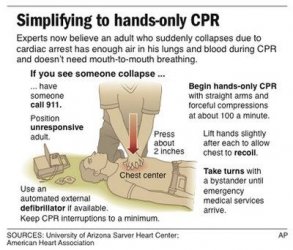Maybe I'm too much of a traditionalist or maybe this just strikes me as things NOT to do ... and that is change from PROVEN methods of resuscitating someone when they cannot breathe or is having a heart attack.
I understand that the idea of putting your mouth to someone else's (particularly a total stranger whom you have NO IDEA who or what they've been kissing/eating or whatever!) can be daunting and make you say EWWW... But is a simple ewww worth a human life?
Oh aids/HIV... hmm good point... then get yourself some of these http://www.iprepare.com/cprmouthpiece.html or
http://www.alwaysbeprepared.com/site/558697/product/FA-2SUM or
http://www.firstaidmonster.com/ambu-res-cue-resuscitation-mask-p-5460.html or even...
http://www.firstaidmonster.com/cpr-micro-shield-rescue-breather-in-orange-pouch-p-5890.html
and keep them in your car or briefcase or purse or backpack or whatever it is you carry around your OTHER non-essentials/essentials in.
Oxygen needs to be there to prevent brain damage.
Besides I think a lot of people don't realize that once you've learned CPR and are current you are required to utilize it unless someone else or EMS is on the scene.
Don't want to get sick, or taste their recent dinner? Then get a shield and keep it near you...
Yeah, can't carry it EVERYWHERE but :idunno: nice to have when you got it eh?
I love how it says EXPERTS now believe... oh they haven't proven it? *scoffs*... sorry to dis on experts but hey... like I just said... if it ain't broken don't fix it... the most recent/current method is jes fine.
ATLANTA More bystanders are willing to attempt CPR if an emergency dispatcher gives them firm and direct instructions especially if they can just press on the chest and skip the mouth-to-mouth, according to new research.
The two new studies conclude that "hands-only" chest compression is enough to save a life. They are the largest and most rigorous yet to suggest that breathing into a victim's mouth isn't needed in most cases.
The American Heart Association has been promoting hands-only CPR for two years, though it's not clear how much it's caught on. The new studies should encourage dispatchers and bystanders to be more aggressive about using the simpler technique.
"That could translate into hundreds if not thousands of additional lives saved each year. What are we waiting for?" said Dr. Arthur Kellermann, a RAND Corporation expert on emergency medicine.
An estimated 310,000 Americans die each year of cardiac arrest outside hospitals or in [COLOR=#366388 ! important][COLOR=#366388 ! important]emergency [COLOR=#366388 ! important]rooms[/COLOR][/COLOR][/COLOR]. Only about 6 percent of those who are stricken outside a hospital survive.
When someone collapses and stops breathing, many people panic and believe that phoning 911 is the best they can do to help.
http://news.yahoo.com/s/ap/20100728/ap_on_he_me/us_med_hands_only_cpr
I understand that the idea of putting your mouth to someone else's (particularly a total stranger whom you have NO IDEA who or what they've been kissing/eating or whatever!) can be daunting and make you say EWWW... But is a simple ewww worth a human life?
Oh aids/HIV... hmm good point... then get yourself some of these http://www.iprepare.com/cprmouthpiece.html or
http://www.alwaysbeprepared.com/site/558697/product/FA-2SUM or
http://www.firstaidmonster.com/ambu-res-cue-resuscitation-mask-p-5460.html or even...
http://www.firstaidmonster.com/cpr-micro-shield-rescue-breather-in-orange-pouch-p-5890.html
and keep them in your car or briefcase or purse or backpack or whatever it is you carry around your OTHER non-essentials/essentials in.
Oxygen needs to be there to prevent brain damage.
Besides I think a lot of people don't realize that once you've learned CPR and are current you are required to utilize it unless someone else or EMS is on the scene.
Don't want to get sick, or taste their recent dinner? Then get a shield and keep it near you...
Yeah, can't carry it EVERYWHERE but :idunno: nice to have when you got it eh?
I love how it says EXPERTS now believe... oh they haven't proven it? *scoffs*... sorry to dis on experts but hey... like I just said... if it ain't broken don't fix it... the most recent/current method is jes fine.

